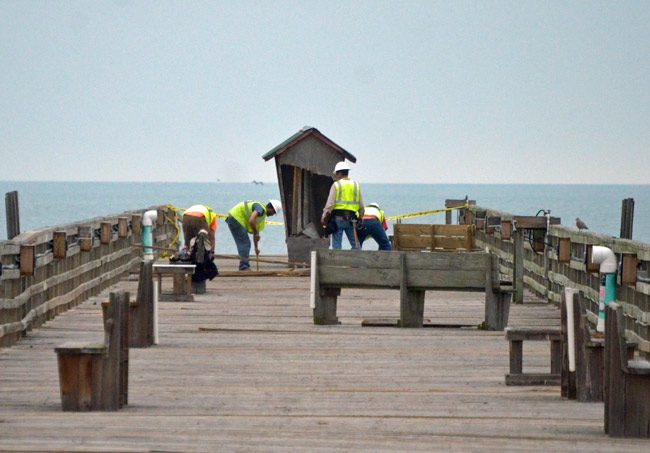
You could hear the unmistakable sound of hammering on the Flagler Beach Pier this morning, music to Pier lovers who could also see the bobbing white hard hats of a quartet of workers at the very end of the shredded structure. Some 160 feet of it were sheared off by Hurricane Matthew last October. That segment isn’t coming back just yet. But Wednesday was the first day of work for the city’s contractor, hired to carry out emergency repairs on the pier for just under $1 million and make it walkable, fishable and danceable by May.
The longer-repairs, or reconstruction, of the pier will take much longer, and based on the first conceptual look at what’s ahead, that new structure may not be ready until 2021 at the earliest. It may also look quite a bit different from the pier’s wooden rusticity today.
Atkins Coastal Engineering, the consultant the city hired, presented those concepts at an open house earlier this week (on Feb. 28). They include the possibility of a much longer pier, extending as long as 1,100 feet (or more than 300 feet longer than the original pier), but also of dual piers: the existing wooden one would remain, but would be paired with a longer, concrete one, a logistical convenience that might be the answer to the risk of leaving the city without a pier come the next severe storm, but a convenience with little concern for aesthetics.
Then again, that’s what the conceptual stage is for: to float ideas and see what appeals to residents most, and what’s most feasible to get financed through the Federal Emergency Management Administration, without whose money–and buy-in–a new pier would scarcely be possible, especially when county government is saddled with multi-million dollar beach-fixing burdens of its own.
“I don’t want to wait until the last minute to get feedback,” Flagler Beach City Manager Larry Newsom said. “We’re not designing it. These are concepts. You want to work out concept before you get into design, because we still have to sit down with FEMA and ask them what will you fund.”
But nothing says that a concrete pier is invulnerable: Jacksonville Beach has the longest fishing pier on the state’s Atlantic coast, at 1,300. It’s concrete. Or was. It’s now closed indefinitely, as it lost 350 feet of its furthest edge to Hurricane Matthew.
Repairs could take two years, and the city is looking at suing the pier’s builder, Edward Waters and Sons, which built it in 2004. The pier was designed in such a way as to have its wood panels blow out in a storm, if necessary, to relieve pressure, thus protecting the pier’s concrete structure itself from getting destroyed. It didn’t work that way. The storm blew away structural, concrete pillars.
Yet some of the concepts presented in Flagler Beach repeat the very same approach of “blow-out boards” that run down the middle of the pier, and that could presumably be more easily replaced if torn off.
“I like the idea of that because it still allows us to keep our nostalgic boards,” Newsom said, referring to planks that have been engraved with people’s names, a form of local history. “A lot of them are extremely sentimental. We lost a lot of those with Matthew.”
One thing is not too likely: the restoration of the existing pier as it was, as it has never been able to remain since it was built in 1928. According to Atkins research, sections of the pier were lost seven times since it was built, the first time in 1944, when half of it was lost, with 400-foot sections lost in 1964 and 1984, and 180 feet lost during the 2005 hurricane season. Restoring it to its wooden stature is an option.
But so is replacing it. The newre pier, if concrete, could extent much further into the sea, to the delight of fishermen, who could fish for additional species, it could be wider, it could have a t-shaped end or an octagonal end, it could have long rows of benches, even bathrooms, and would be made accessible to the disabled in every way, including for fishing.
But the longer the pier, the less likely the preservation of its wooden look.
And all of that will depend on funding. Even if the money is secured, Atkins projects a timeline of no less than 52 months, or upwards of four years, from planning to construction to completion, with design, permitting and regulatory hurdles along the way.
See the complete Atkins report below.
![]()
Flagler Beach Pier Conceptual Report (2017)
Click to access Atkins-Presentation-Pier-Concepts-02.28.2017-1.pdf





























Richard Smith says
Frankly it doesn’t matter what material is used to rebuild the pier, someday it will be destroyed once again. Why not charge the public using the pier an appropriate amount of money daily and then use that money to form a pier restoration reserve for the future. Plus keep the politicians hands off of it so it can ONLY be used for maintenance or rebuilding the pier from any storm damage. A penny saved is a dollar earned.
Jay says
They already charge you to go out on it Richard
Jason says
Our Pier is actually one of the more expensive Piers around it definitely matters what it is built from! I have built many homes around town and also had the privilege of working on the “big” bridge so as someone w/local knowledge of building techniques and materials I would have to say concrete is the way to go as I’ve told the City for the past 20yrs.
Richard Smith says
Yeah..I know but where does all of that money go? With all of the temporary repairs being done and then attempting to do permanent repairs I would think that an increase in the fee would be appropriate.
Anonymous says
A longer more sound pier makes good sense IMO
Anonymous says
Did Any Of Flagler’s Homeless Reply On How They Would Like To See The Pier Rebuilt?